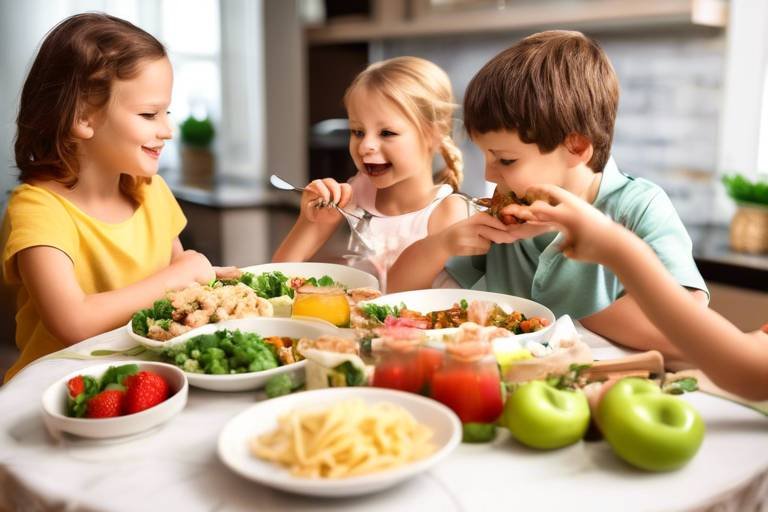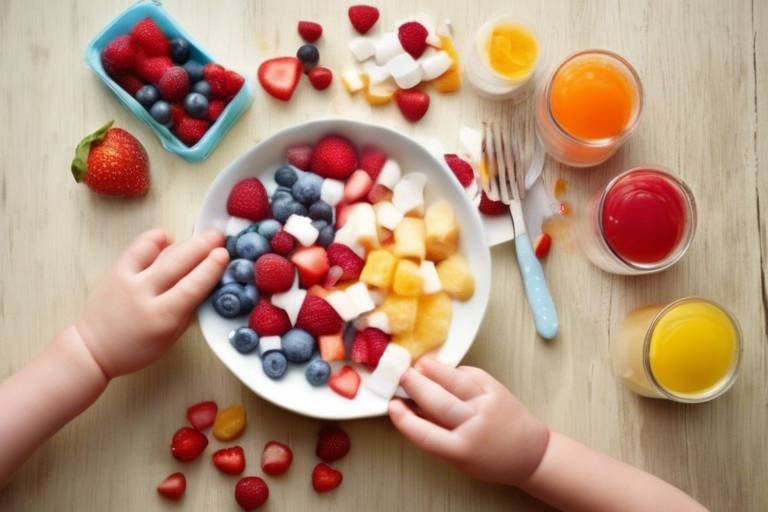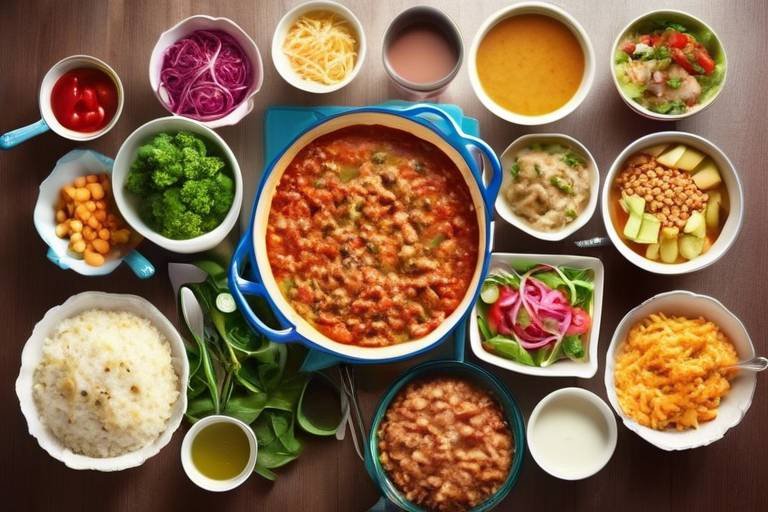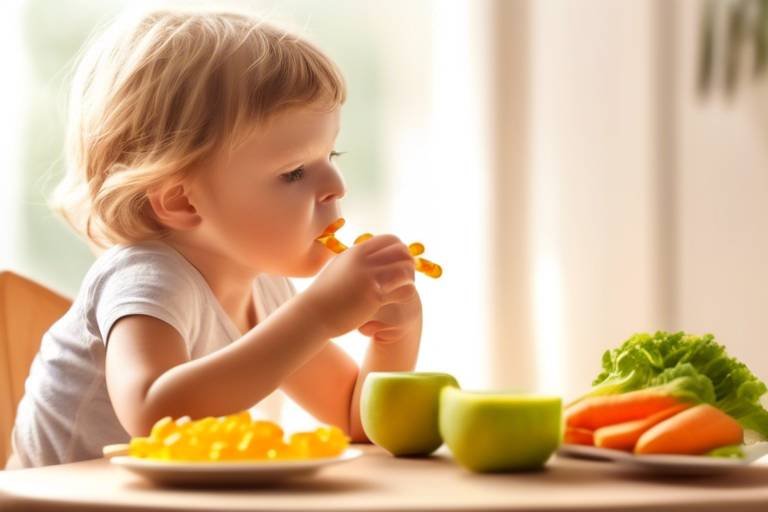How to Handle Junk Food Cravings in Kids
As parents, we all know that the battle against junk food cravings in kids can feel like an uphill climb. It's almost as if junk food has a magnetic pull on them, right? But fear not! This article dives deep into effective strategies to manage those cravings, promote healthier eating habits, and foster a positive relationship with food. By understanding the roots of these cravings and providing healthier alternatives, we can pave the way for our children to enjoy nutritious foods while still having fun. So, let’s embark on this journey together and discover how to make healthy eating a delightful adventure!
First things first, let’s get to the bottom of why kids crave junk food. It’s not just about taste; there are psychological and physiological factors at play. Kids often find themselves drawn to sugary snacks and salty chips due to emotional triggers—think comfort after a tough day or reward after a good behavior. Furthermore, let’s not overlook the powerful impact of advertising. Those colorful commercials and flashy packaging can make even the most nutritious carrot stick seem dull in comparison! Understanding these factors is crucial for addressing cravings effectively.
Now that we’ve unpacked the reasons behind those cravings, let’s explore some nutritious snack options that can satisfy kids’ desires without compromising their health. The goal here is to provide options that are not only healthy but also fun and appealing. After all, who says healthy eating has to be boring? Here are some ideas:
- Fruits: Nature's candy! Think apples, bananas, and berries.
- Vegetables: Carrot sticks, bell pepper slices, and cucumbers can be crunchy and satisfying.
- Homemade Treats: Get creative in the kitchen! You can whip up some delicious snacks that are both healthy and tasty.
Getting kids to eat fruits and vegetables can sometimes feel like pulling teeth. But with a little creativity, you can make these healthy foods more enticing! For instance, try turning fruit into fun shapes or creating a colorful fruit salad. The visual appeal can make a world of difference. And don’t forget about the power of dips! Pairing fruits with yogurt or veggies with hummus can transform them into irresistible snacks.
Want to captivate your child’s attention? How about preparing some vibrant fruit snacks? You can create fruit kabobs using a mix of their favorite fruits. Not only are they fun to eat, but they’re also a great way to sneak in some vitamins and minerals. You could even involve your kids in the preparation process, making it a fun family activity!
If you want to make vegetables more appealing, try whipping up some flavorful dips and spreads. A creamy avocado dip or a zesty yogurt-based dressing can make carrot sticks and bell peppers much more enticing. Kids love to dip, and this simple addition can turn a mundane snack into a party for their taste buds!
Let’s face it: store-bought treats can be loaded with hidden sugars and preservatives. Why not take control of what your kids eat by making homemade snacks? Simple recipes like energy balls made with oats, nut butter, and honey can satisfy sweet cravings while providing essential nutrients. Plus, involving your kids in the cooking process can be a fantastic way to teach them about healthy eating!
While it’s important to provide healthy options, setting boundaries around junk food consumption is equally crucial. Kids thrive on routine and structure, so establishing healthy limits around treats can help them develop a balanced relationship with food. It’s all about communication—explain why these boundaries exist and how they can still enjoy their favorite snacks in moderation.
Designing a meal plan that includes treats in moderation can be a game-changer. Think of it as a roadmap that guides your family toward healthier eating habits. Incorporate a mix of fruits, vegetables, whole grains, and lean proteins, while allowing for occasional treats. This approach not only nourishes their bodies but also teaches them about balance and moderation.
One of the best ways to encourage healthier eating habits is to involve kids in the decision-making process. Take them grocery shopping and let them pick out fruits and vegetables they want to try. This sense of ownership can foster a sense of responsibility and make them more inclined to eat what they’ve chosen. Plus, it can be a fun bonding experience!
Q: How can I make healthy snacks more appealing to my kids?
A: Get creative! Use fun shapes, colors, and dips to make healthy snacks exciting. Involve your kids in the preparation process to increase their interest.
Q: What should I do if my child refuses to eat fruits and vegetables?
A: Keep offering them in different forms and presentations. Sometimes it takes multiple exposures for kids to develop a taste for certain foods.
Q: Is it okay to let kids have junk food occasionally?
A: Absolutely! Moderation is key. Allowing occasional treats can help kids develop a balanced relationship with food.

Understanding Junk Food Cravings
When it comes to kids and their cravings for junk food, it’s not just about taste; it’s a complex mix of psychological and physiological factors. Children are naturally drawn to sugary, salty, and fatty foods, often because these flavors are associated with happiness and reward. Think about it: when was the last time you celebrated a birthday without cake or enjoyed a movie night without popcorn? These foods are often linked to positive experiences, making them hard to resist.
Moreover, the impact of advertising cannot be overlooked. Kids are bombarded with colorful commercials and catchy jingles that glorify junk food. This constant exposure creates a sense of desire and urgency; they see their favorite cartoon characters munching on sugary cereals or fast food, and they want in on that fun. It's like planting a seed of craving that can grow into a full-blown obsession if not managed properly.
Another significant factor is emotional triggers. Children, like adults, can turn to food for comfort. Feeling sad, bored, or even excited can lead to a desire for junk food. For instance, after a long day at school, a child might crave a cookie or a bag of chips as a way to unwind. This emotional connection can create a cycle where kids rely on junk food to cope with their feelings, making it even more challenging to steer them toward healthier options.
To better understand these cravings, let’s break down some of the common factors at play:
- Biological Factors: Kids have a natural preference for sweet and fatty foods, which can trigger cravings.
- Social Influences: Peer pressure and family habits can shape their food choices.
- Emotional Connections: Food can serve as a comfort during stressful or emotional times.
- Marketing Tactics: Advertisements often target children, making junk food appealing and desirable.
Understanding these factors is crucial for parents who want to help their children develop a healthier relationship with food. By recognizing the reasons behind junk food cravings, you can implement strategies that not only satisfy your child's cravings but also promote healthier eating habits. It’s all about finding that balance, ensuring that kids enjoy their favorite treats while also being mindful of their overall nutrition.

Healthy Alternatives to Junk Food
When it comes to kids and their cravings for junk food, it's easy to feel overwhelmed as a parent. The bright packaging, catchy jingles, and sugary flavors seem to have a magnetic pull on children. However, there are plenty of nutritious alternatives that can satisfy those cravings without compromising their health. The key is to get creative and make healthy options just as appealing as their junk food counterparts.
One of the best strategies is to incorporate fruits and vegetables into their snacking routine. Think of fruits as nature’s candy! They’re sweet, colorful, and packed with vitamins. You could set up a fun fruit bar at home, where kids can mix and match their favorite fruits. Imagine a vibrant display of strawberries, blueberries, and kiwi slices, all ready to be dipped in a light yogurt. This not only makes snacking fun but also encourages kids to explore new flavors and textures.
Getting kids excited about fruits and vegetables doesn't have to be a chore. One effective method is to make these healthy foods accessible and visually appealing. For instance, you could create a colorful fruit salad or arrange vegetables in a rainbow pattern on a plate. When they see their food looking like a work of art, they’re more likely to dig in! You can even involve them in the preparation process. Kids love to help out in the kitchen, and by letting them wash, peel, or arrange the fruits and veggies, they’ll feel a sense of ownership over their meals.
To make fruit snacks even more enticing, consider preparing fruit kabobs. Simply thread pieces of their favorite fruits onto skewers, and voilà! You’ve got a fun and portable snack that’s perfect for after school or playdates. You can also freeze fruits like grapes or banana slices for a refreshing treat on hot days. These frozen snacks not only taste delicious but also provide a satisfying crunch that can rival any store-bought junk food.
Now, let’s talk about vegetables. They often get a bad rap, but with the right dips, they can become a snack-time superstar. Think about creating a variety of flavorful dips, such as hummus, guacamole, or a yogurt-based ranch dip. You can serve these with crunchy carrot sticks, cucumber slices, or bell pepper strips. The creamy texture of the dips can mask any bitterness of the veggies, making them much more appealing to little taste buds.
For a fun twist, you could even host a “dip party” where kids can create their own combinations. Set up a table with different vegetables, dips, and toppings, and let them experiment. This not only makes eating vegetables fun but also encourages them to try new things without pressure.
Another fantastic way to satisfy cravings is by preparing homemade treats. This gives you complete control over the ingredients, allowing you to create snacks that are both delicious and nutritious. For example, you can whip up some energy balls made from oats, nut butter, and a hint of honey. These bites are not only easy to make but also provide a wonderful energy boost for active kids. You can even let them choose their favorite mix-ins, like chocolate chips or dried fruits, to make the experience more engaging.
By offering these healthy alternatives, you can help your kids develop a positive relationship with food. Instead of viewing healthy eating as a punishment, they’ll start to see it as an adventure filled with exciting flavors and textures. Remember, the goal is not to eliminate junk food entirely, but rather to create a balanced approach that includes plenty of nutritious options while still allowing for the occasional treat.
Q: How can I make healthy snacks more appealing to my kids?
A: Use colorful presentations, involve them in the preparation, and create fun combinations like fruit kabobs or veggie dips to make healthy snacks exciting.
Q: What are some quick healthy snack ideas for busy days?
A: Some quick options include yogurt with fruit, nut butter on whole grain crackers, or pre-cut veggies with hummus. These snacks are easy to prepare and perfect for on-the-go.
Q: Is it okay to let kids have junk food occasionally?
A: Absolutely! Moderation is key. Allowing occasional treats can help kids learn balance and prevent them from feeling deprived.

Incorporating Fruits and Vegetables
Getting kids to eat their fruits and vegetables can sometimes feel like trying to convince a cat to take a bath. It’s a challenge, but with a little creativity and enthusiasm, you can turn these nutritious foods into exciting snacks that your kids will love. The key is to make fruits and vegetables not just healthy options, but also fun and appealing. Think of it as a culinary adventure where you’re the guide, leading your little explorers toward healthier choices!
One effective strategy is to involve your kids in the preparation process. When children help in the kitchen, they’re more likely to try new foods. You can start by letting them pick out fruits and vegetables during grocery shopping. Ask them to choose a colorful variety—this not only makes it visually appealing but also ensures a range of nutrients. Once you’re back home, set up a mini cooking session. For example, you could create a fruit salad together, allowing them to chop (with supervision) and mix their favorite fruits. This hands-on approach can significantly increase their willingness to taste what they’ve made.
Another exciting way to incorporate more fruits and vegetables is through fun presentations. For instance, you can arrange sliced fruits into fun shapes or create a rainbow plate with a variety of colors. Kids are naturally drawn to bright colors, so why not make their plate look like a work of art? You can also use cookie cutters to shape vegetables into stars or hearts, making them more enticing. Remember, the more creative you are, the more likely they are to say, “Yes, I want to eat that!”
Don’t forget about the power of dips! Kids often love to dip their food, so pairing veggies with a tasty dip can be a game changer. Consider making a simple yogurt-based dip or hummus to accompany carrot sticks, cucumber slices, and bell pepper strips. Not only does this add flavor, but it also makes the vegetables feel like a special treat rather than just a side dish. You could even host a “dip party” where kids can try different dips with various vegetables, turning snack time into a fun activity.
Here’s a quick table to illustrate some creative ways to serve fruits and vegetables:
| Fruit/Vegetable | Fun Serving Idea |
|---|---|
| Apple Slices | Serve with peanut butter for dipping |
| Carrot Sticks | Cut into fun shapes and pair with ranch dressing |
| Berries | Create a berry parfait with yogurt and granola |
| Bell Peppers | Stuff with cheese or hummus for a colorful snack |
By incorporating these strategies, you can transform the way your child views fruits and vegetables. The goal is to create a positive association with healthy foods, making them a natural part of their diet. Remember, it’s not just about nutrition; it’s about building lifelong habits that will help your children thrive. So, roll up your sleeves, get creative, and watch as your kids start to embrace the vibrant world of fruits and vegetables!
- How can I make fruits and vegetables more appealing to my kids? Try involving them in the cooking process, using fun presentations, and pairing them with tasty dips.
- What are some easy ways to include more fruits in my child's diet? Consider making smoothies, fruit salads, or yogurt parfaits that include a variety of fruits.
- Can I sneak vegetables into meals? Yes, blending vegetables into sauces or soups can be a great way to include them without your child noticing.

Fun Fruit Snacks
When it comes to satisfying those pesky junk food cravings in kids, can be a game changer! Imagine transforming ordinary fruits into exciting, colorful creations that not only tantalize their taste buds but also make healthy eating feel like a treat. The key is to get creative and think outside the box. Instead of just slicing up an apple, why not turn it into a delightful fruit kebab? Skewering pieces of apple, banana, and strawberries on a stick can make the experience feel like a fun adventure rather than a mundane snack time.
Another fantastic idea is to create fruit faces. Let’s say you have some grapes, a banana, and a few blueberries. You can use these to construct silly faces on a plate. This not only makes for an Instagram-worthy snack but also encourages kids to eat their fruits without even realizing it. Plus, the act of creating something visually appealing can spark their creativity and make them more interested in what they’re eating.
For those hot summer days, why not freeze some fruit to make delicious and refreshing fruit popsicles? Simply blend your favorite fruits with a bit of yogurt or juice, pour them into molds, and freeze. Voila! You’ve got yourself a healthy, icy treat that rivals any store-bought popsicle. Kids will be thrilled to enjoy these homemade goodies, and you can feel good knowing exactly what went into them.
Here’s a quick recipe for a fun fruit salad that’s sure to be a hit:
| Fruit | Benefits |
|---|---|
| Strawberries | Rich in Vitamin C and antioxidants |
| Bananas | Great source of potassium and energy |
| Kiwi | High in Vitamin C and dietary fiber |
| Mango | Loaded with vitamins A and C |
Simply chop up these fruits, toss them together in a bowl, and let your kids add their favorite toppings, like a sprinkle of granola or a drizzle of honey. This not only gives them a delicious snack but also allows them to take part in the preparation process, making it even more enjoyable.
Ultimately, the goal is to make fruit as enticing as those sugary snacks. By incorporating fun, creative elements into fruit snacks, you can help your kids develop a love for healthy eating. Remember, it’s all about making it an enjoyable experience. So, roll up your sleeves and get ready to have some fun in the kitchen!
Q1: What are some easy fruit snacks I can prepare?
A1: You can prepare fruit kebabs, fruit faces, or fruit popsicles. These are not only easy to make but also visually appealing to kids!
Q2: How can I encourage my kids to eat more fruits?
A2: Get creative with presentation! Use fun shapes, colors, and even involve them in the preparation. Making it a fun activity can encourage them to try more fruits.
Q3: Are frozen fruits just as healthy as fresh fruits?
A3: Yes! Frozen fruits can retain their nutritional value and are a great alternative when fresh fruits are not available. Just ensure there are no added sugars or preservatives.

Vegetable Dips and Spreads
When it comes to getting kids to eat their vegetables, the secret often lies in the dips and spreads that accompany them. Imagine a colorful platter filled with fresh, crunchy veggies, just waiting to be dunked into a creamy, flavorful dip. It’s like turning a simple snack into a fun and interactive experience! Kids are naturally drawn to vibrant colors and exciting textures, so why not take advantage of that? By introducing , you can transform the way your children perceive healthy eating.
One of the most popular choices is hummus. This chickpea-based spread is not only rich in protein but also incredibly versatile. You can add various flavors like roasted garlic, sun-dried tomatoes, or even a hint of spicy sriracha to keep things interesting. Pair it with carrot sticks, cucumber slices, or bell pepper strips, and watch your kids dive in with enthusiasm. The creamy texture of hummus makes it an appealing option that can turn even the most reluctant veggie eater into a fan.
Another fantastic option is a yogurt-based dip. Mixing Greek yogurt with fresh herbs like dill or parsley can create a refreshing and zesty dip that pairs wonderfully with raw veggies. You can even add a splash of lemon juice or a pinch of garlic powder to enhance the flavor. This not only provides a delicious way to enjoy vegetables but also offers a dose of probiotics that are beneficial for gut health. Plus, it’s easy to make and can be customized to suit your child’s taste preferences.
For those who love a little kick, consider a spicy avocado dip. Avocados are packed with healthy fats, and when blended with lime juice, cilantro, and a touch of jalapeño, you get a creamy dip that’s bursting with flavor. Serve it alongside crunchy tortilla chips or fresh veggies, and you’ll have a snack that feels indulgent but is still nutritious. Kids will love the vibrant green color and the smooth texture, making it a perfect addition to their snack time.
To make it even more engaging, why not involve your kids in the dip-making process? Let them choose the vegetables they want to pair with their dips, and even allow them to help prepare the dips themselves. This not only fosters a sense of ownership over their food choices but also makes them more likely to try new things. After all, when kids are involved in the kitchen, they’re more likely to be excited about what’s on their plate!
In conclusion, vegetable dips and spreads can be a game-changer in promoting healthy eating habits among kids. By making vegetables fun and flavorful, you can encourage your children to explore a variety of tastes and textures. So, next time you're preparing snacks, consider whipping up a batch of homemade dips that will not only satisfy their cravings but also pave the way for a lifetime of healthy eating habits.
- What are some easy vegetable dip recipes? You can try simple recipes like hummus, yogurt dips, or avocado spreads, all of which are quick to make and delicious!
- How can I encourage my kids to eat more vegetables? Involve them in the preparation process and pair veggies with fun dips to make them more appealing.
- Are store-bought dips healthy? Some store-bought dips can be high in preservatives and unhealthy fats, so it's best to check the labels or opt for homemade versions.

Homemade Treats
When it comes to satisfying kids' cravings for junk food, can be a game-changer. Not only do they allow you to control the ingredients, but they also provide an opportunity to create delicious snacks that are both healthy and fun. Imagine whipping up a batch of chocolate avocado brownies or banana oat cookies—treats that feel indulgent but are packed with nutrients! By making snacks at home, you can cut out the preservatives and added sugars often found in store-bought options, ensuring that your kids are fueling their bodies with wholesome food.
One of the best parts about homemade treats is the chance to get creative in the kitchen. For instance, you can involve your children in the cooking process, turning it into a fun family activity. This not only teaches them valuable skills but also fosters a positive relationship with food. Try making energy balls together, which can be customized with various ingredients like oats, nut butter, honey, and even chocolate chips. The possibilities are endless! Plus, kids are more likely to enjoy snacks they helped create.
Here are a few ideas for that can satisfy those junk food cravings:
- Fruit Popsicles: Blend your child's favorite fruits with yogurt or juice, pour the mixture into molds, and freeze. These are refreshing and naturally sweet!
- Homemade Granola Bars: Mix oats, honey, nut butter, and a variety of mix-ins like dried fruits or seeds. Press the mixture into a pan, refrigerate, and cut into bars.
- Yogurt Parfaits: Layer yogurt with fresh fruits and granola in a cup for a visually appealing and nutritious snack.
Not only are these treats healthier, but they can also be tailored to your child's tastes. For example, if your child loves peanut butter, you might consider making peanut butter energy bites with oats, honey, and chocolate chips. The key is to experiment and discover what flavors your kids enjoy most. This way, they’ll be more inclined to reach for these healthier options instead of processed snacks.
Moreover, you can use homemade treats as a teaching moment about nutrition. Explain to your kids why certain ingredients are better for them and how they can make healthier choices. This understanding could help them develop a more balanced approach to eating as they grow older. So, the next time a craving strikes, consider heading to the kitchen instead of the store. Your kids will thank you, and their bodies will too!
Q1: What are some easy homemade treats I can make for my kids?
A1: Some easy options include fruit popsicles, homemade granola bars, and yogurt parfaits. These are simple to prepare and can be customized to suit your child's taste.
Q2: How can I get my kids involved in making snacks?
A2: Involve them in the process by letting them choose ingredients or help with mixing and assembling the treats. Making it a fun activity can encourage them to try new foods.
Q3: Can homemade treats be stored for later use?
A3: Yes! Most homemade treats can be stored in airtight containers in the fridge or freezer, making them convenient for quick snacks throughout the week.
Q4: Are homemade treats healthier than store-bought options?
A4: Generally, yes! Homemade treats allow you to control the ingredients, reducing added sugars and unhealthy fats, and making them a healthier choice for your kids.

Setting Healthy Boundaries
Setting healthy boundaries around junk food consumption is crucial for fostering a positive relationship with food in children. It's not just about saying "no" to unhealthy snacks; it's about creating an environment where kids can learn to make better choices without feeling deprived. Imagine a world where your child understands that treats can be enjoyed in moderation, much like a rollercoaster ride—thrilling but not something you want to do every day!
One effective approach is to establish clear guidelines for when and how often junk food can be consumed. For instance, you might decide that junk food is reserved for special occasions, like family movie nights or birthday parties. By framing these moments as special, you create anticipation and excitement, rather than a sense of scarcity. This way, children learn to appreciate treats without feeling like they are missing out.
Additionally, communication is key. Talk to your kids about why certain foods are better for them than others. Use simple language and relatable analogies. For example, you could explain that fruits and vegetables are like "superheroes" for their bodies, helping them grow strong and stay healthy, while junk food is more like "villains" that can make them feel tired and sluggish. This not only makes the conversation engaging but also helps them understand the importance of balance.
It's also valuable to involve children in the decision-making process. When they feel like they have a say in what they eat, they are more likely to respect the boundaries you set. You could create a fun chart together that outlines when they can have junk food, allowing them to visually see and understand the limits. This sense of ownership can make a world of difference in how they perceive these boundaries.
Another effective strategy is to model healthy behavior yourself. Children are observant and often mimic the habits of their parents. If they see you enjoying a colorful plate of fruits and vegetables while occasionally indulging in a treat, they are likely to adopt a similar mindset. It’s about creating a culture of health within your home. Remember, consistency is key—if you set boundaries, stick to them, and be patient as your children adjust. Over time, they will learn to navigate their cravings with more confidence and understanding.
To illustrate the impact of setting these boundaries, consider the following table that outlines common scenarios and suggested approaches:
| Scenario | Suggested Approach |
|---|---|
| Child asks for junk food after school | Offer a healthy snack first, like fruit or yogurt, and explain that junk food is for special occasions. |
| Family gathering with lots of junk food | Encourage kids to fill their plates with healthy options first and allow them to choose one treat. |
| Child sees junk food ads on TV | Discuss the ads together, explaining how they are designed to make food look appealing and why it’s important to make informed choices. |
By setting healthy boundaries around junk food, you empower your children to make better choices while still enjoying their favorite treats. It’s all about balance and understanding, leading them toward a healthier lifestyle without the constant battle over food. After all, teaching kids to enjoy food responsibly is one of the greatest gifts you can give them!
- How can I introduce healthy snacks to my child? Start by incorporating colorful fruits and vegetables into their meals. Make it fun by involving them in the preparation process!
- What if my child only wants junk food? Gradually introduce healthier options and explain the benefits of balanced eating. Be patient and consistent.
- Can I ever let my child have junk food? Absolutely! The key is moderation. Setting specific times for treats can help them understand balance.

Creating a Balanced Meal Plan
When it comes to for your kids, it’s essential to strike a harmony between nutrition and enjoyment. Imagine a symphony where each food group plays its part, contributing to a melody of health and happiness. A well-structured meal plan not only helps in managing junk food cravings but also ensures that your children receive all the essential nutrients they need for growth and development. So, how do we compose this beautiful symphony of meals?
First, consider incorporating a variety of food groups into each meal. This means including fruits, vegetables, whole grains, proteins, and healthy fats. For instance, a typical day could look something like this:
| Meal | Food Items |
|---|---|
| Breakfast | Oatmeal topped with fresh berries and a spoonful of almond butter |
| Lunch | Whole grain wrap with turkey, spinach, and avocado, served with carrot sticks |
| Snack | Yogurt with sliced banana and a sprinkle of granola |
| Dinner | Grilled chicken, quinoa, and steamed broccoli |
This simple table illustrates how you can mix and match different food items to create balanced meals throughout the day. The key is to make sure each meal has a good mix of macronutrients and micronutrients.
Next, it’s important to set boundaries around treats. Allowing your kids to indulge in their favorite snacks occasionally can actually help them develop a healthier relationship with food. By incorporating treats into the meal plan in moderation, you can teach them that it’s okay to enjoy junk food without overindulging. For example, you might designate Friday as “Treat Day,” where they can choose a favorite snack, which not only gives them something to look forward to but also reinforces the idea of balance.
Moreover, involving your kids in the meal planning process can make a significant difference. Ask them what fruits and vegetables they like, or let them help you pick out recipes. This engagement fosters a sense of responsibility and ownership over their food choices. It’s like giving them the conductor's baton in our meal symphony, allowing them to lead the way in creating their own healthy habits.
Finally, don’t forget to keep things fun and colorful. Kids are naturally drawn to bright colors and interesting shapes, so make your meals visually appealing. Use cookie cutters to shape fruits and sandwiches, or create a rainbow plate with a variety of colorful vegetables. The more enticing the meal looks, the more likely they are to eat it!
In conclusion, creating a balanced meal plan is not just about nutrition; it’s about crafting a delightful experience that your children will cherish. By incorporating a variety of food groups, setting healthy boundaries, involving your kids in the process, and making meals visually appealing, you can ensure that your children not only eat well but also enjoy the journey of healthy eating.
- How can I get my kids to eat more vegetables? Involve them in the cooking process, and present vegetables in fun and creative ways.
- What are some healthy snacks for kids? Consider options like yogurt with fruit, whole grain crackers with cheese, or homemade trail mix.
- Is it okay to let kids have junk food? Yes, moderation is key. Allowing treats occasionally can help prevent feelings of deprivation.
- How can I make meal planning easier? Prepare meals in advance, and create a weekly menu to simplify grocery shopping.

Involving Kids in Food Choices
Getting your kids involved in their food choices can be a game changer when it comes to establishing healthy eating habits. Imagine this: instead of simply telling your child what they should eat, you invite them into the kitchen, making them part of the culinary adventure. This not only empowers them but also fosters a sense of responsibility and ownership over their diet. When children feel like they have a say in what goes on their plate, they're more likely to embrace healthier options and step away from the allure of junk food.
So, how do you get started? First, consider involving them in the grocery shopping process. Take them to the store and let them choose from a selection of fruits and vegetables. You can create a fun challenge, like picking out a new fruit or vegetable each week. This not only makes shopping exciting but also introduces them to a variety of healthy foods they might not have tried before. You could even create a small chart to track the new items they try, making it a fun project that they can look forward to.
Once you're back in the kitchen, let them help with meal preparation. Kids love to help, and involving them in cooking can turn a mundane task into a fun family activity. They can wash veggies, stir ingredients, or even assemble their own snacks. For instance, you could set up a "make-your-own" veggie wrap station where they can choose their favorite fillings. This hands-on approach makes them more likely to eat what they’ve helped create, and it’s a fantastic opportunity to teach them about nutrition and the importance of a balanced diet.
Additionally, consider organizing a family cooking night where everyone contributes to the meal. You can assign different roles, such as one person handling the salad, another in charge of the main dish, and someone else preparing dessert. This teamwork not only enhances their culinary skills but also strengthens family bonds. Plus, it’s a great way to discuss the ingredients and their health benefits while you cook together.
Involving kids in food choices also means teaching them to read labels and understand what goes into the food they eat. This can be a fun learning experience where you explain the difference between healthy and unhealthy ingredients. You can even have a little game where they compare two products and decide which one is the better choice based on what they’ve learned. This educational aspect is crucial, as it equips them with the knowledge to make healthier decisions in the future.
Lastly, don’t forget to celebrate their choices! When your child chooses a healthy snack or helps prepare a nutritious meal, praise their efforts. Positive reinforcement goes a long way in encouraging them to continue making healthy choices. You might even consider creating a "Healthy Choices" reward system where they earn points for each healthy decision they make, which can be redeemed for fun family activities or a small treat. This not only motivates them but also makes healthy eating a fun and rewarding experience.
In summary, involving kids in food choices is about more than just what they eat; it’s about teaching them valuable life skills, fostering a love for healthy foods, and creating lasting family memories. So, why not start today? Turn mealtime into a fun, collaborative effort that everyone can enjoy!
- Why is it important to involve kids in food choices?
Involving kids helps them develop a sense of responsibility, encourages healthier eating habits, and fosters a positive relationship with food. - What are some fun activities to engage kids in food preparation?
Activities like grocery shopping, cooking nights, and creating DIY snack stations can make food preparation enjoyable for children. - How can I teach my child to read food labels?
Make it a game by comparing products and discussing the ingredients, helping them understand what makes a food healthy or unhealthy.
Frequently Asked Questions
- What are some common reasons for junk food cravings in kids?
Kids often crave junk food due to a combination of psychological and physiological factors. Emotional triggers, such as stress or boredom, can lead them to seek comfort in sugary or salty snacks. Additionally, the pervasive influence of advertising and the appealing nature of junk food can make it hard for kids to resist.
- How can I introduce healthier snacks to my children?
Introducing healthier snacks can be fun and engaging! Start by making nutritious options like fruits and vegetables more appealing. Consider creating colorful fruit skewers or fun-shaped veggie slices. You can also involve your kids in the preparation process, making them more excited about trying new, healthy snacks.
- What are some creative ways to incorporate fruits and vegetables into my child's diet?
Get creative with fruits and veggies! Try blending them into smoothies, making homemade fruit popsicles, or using them as toppings for yogurt or cereal. You can even create a “veggie dip party” where kids can choose their favorite dips to enjoy with fresh vegetables, turning healthy eating into a delightful experience.
- How can I set healthy boundaries around junk food consumption?
Setting healthy boundaries involves clear communication and consistency. Explain to your kids why it's important to limit junk food, and establish specific times or occasions when they can enjoy their favorite treats. This way, they learn moderation while still feeling like they have some control over their choices.
- What role does involving kids in food choices play in promoting healthy eating?
Involving kids in food choices empowers them and fosters a sense of responsibility. When they help select fruits, vegetables, or even participate in meal planning, they are more likely to appreciate and choose healthier options. This engagement can also spark their curiosity about nutrition and cooking!
- Can homemade treats be a healthier alternative to store-bought options?
Absolutely! Homemade treats allow you to control the ingredients, making them a healthier alternative to many store-bought snacks. You can experiment with whole grains, natural sweeteners, and healthy fats, ensuring that the treats are both delicious and nutritious for your kids.



















